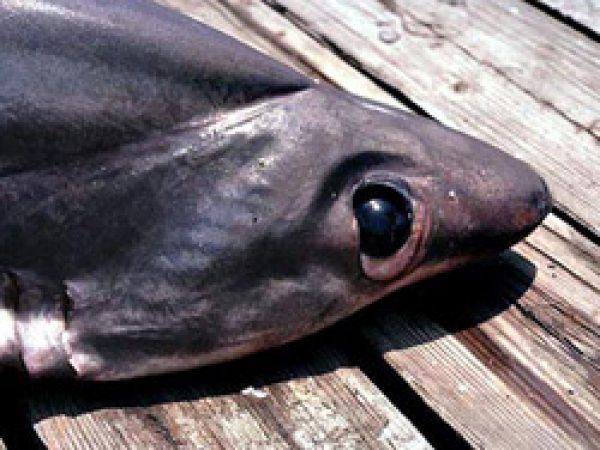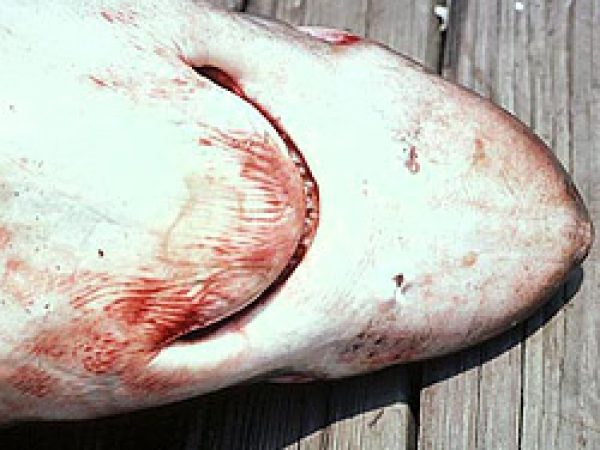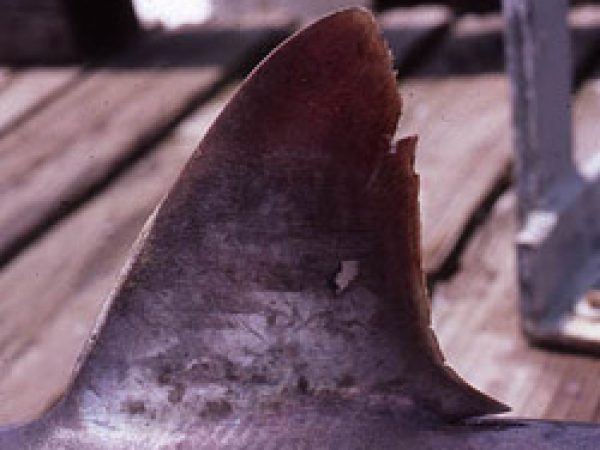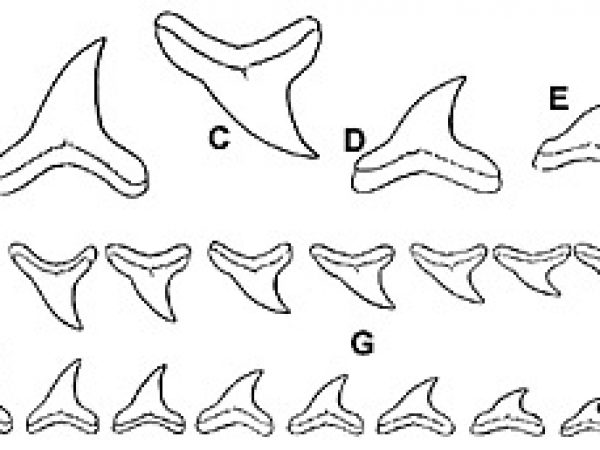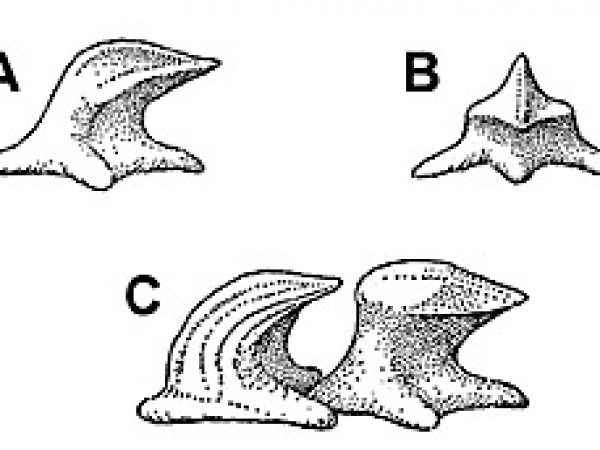Alopias superciliosus
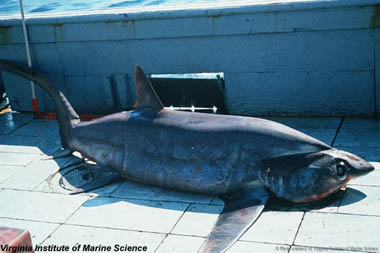
The bigeye thresher has the long tail of most thresher sharks (nearly half its body length is the upper caudal lobe or top half of the tail), but this one gets its name from its large eyes, adapted for seeing in low light. It practices diel vertical migration, meaning it spends the day in deep water, and comes to the surface at night to eat small fish and squid, which it stuns with its long tail. There are no reported unprovoked attacks by this shark so it is considered no harm to humans.
Order – Lamniformes
Family – Alopiidae
Genus – Alopias
Species – superciliosus
Common Names
Common names referring to this shark include bigeye thresher, big eye thresher shark, big-eye thresher, bigeye thresher shark, long-tailed shark, thresher shark, and whiptail. Other language common names are alopias megalomatos (Greek), coleto (Spanish), coludo cebucano (Spanish), grootoog-sambokhaai (Afrikaans), grootoogvoshaai (Dutch), großäugiger drescherhai (German), hachiware (Japanese), jarjur (Arabic), karibiankettuhai (Finnish), pating (Samal), peixe-raposo (Portuguese), peixe-rato (Portuguese), pejerrabo (Spanish), pesce volpe occhio grosso (Italian), pez zorro (Spanish), qatwa albahar (Arabic), raposo-de-olhos-grandes (Portuguese), renard à gros yeux (French), tiburón zorro (Spanish), tiburón zorro de ojo grande (Spanish), tubarão raposo (Portuguese), tubarão raposa de olho grande (Portuguese), zorro (Spanish), zorro de mar (Spanish), zorro negro (Spanish), zorro ojon (Spanish), and zorro olho grande (Portuguese).
Importance to Humans
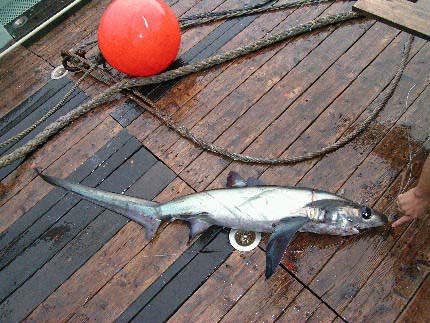
The bigeye thresher is often taken in the longline fisheries in the Indian Ocean and central Pacific Ocean. It is also considered commercially important in the Cuban longline fishery where it is caught at night. However, in waters off the U.S., this shark is considered a nuisance bycatch of the swordfish longline fishery. It is also taken in bottom and pelagic gillnets and trawls as well as by sportfishing gear. The flesh is not highly regarded for human consumption due to its mushy texture, however it is consumed fresh, smoked, dried and salted. The skin is used to make leather products and the fins for shark fin soup in Asia.
Danger to Humans
According to the International Shark Attack File, there have been no reported unprovoked attacks by thresher sharks. Furthermore, the pelagic habitat this shark prefers limits its chances of encountering swimmers. It is considered harmless to humans.
Conservation
Low fecundity and slow growth make the bigeye thresher vulnerable to longline and gillnet fisheries.
> Check the status of the bigeye thresher at the IUCN website.
The IUCN is a global union of states, governmental agencies, and non-governmental organizations in a partnership that assesses the conservation status of species.
Geographical Distribution
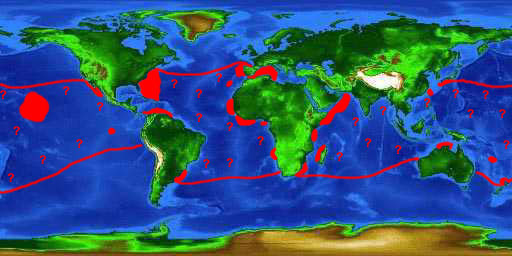
In the U.S., the distribution of the bigeye thresher ranges from the coast of New York to Florida and from the California coast to the Gulf of California and south of the Hawaiian Islands. This shark is also found in Cuban waters as well as tropical waters worldwide off the coasts of Portugal to Angola to South Africa, as well as off the coasts of northwest Australia, New Zealand, southern Japan, and Taiwan.
Habitat
The bigeye thresher is found in warm, temperate and tropical oceanic and coastal waters from the surface to depths of 500 feet (152.3 m). Found nearly worldwide, it has a preference for surface temperatures of 61° to 77°F (16.1°C-25°C). Bigeye threshers occasionally enter shallow waters near land but generally are found in the open sea.
Distinguishing Characteristics
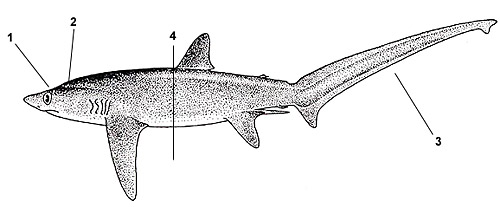
1. Eyes are large and directed upward
2. Head has deep grooves along top
3. Caudal fin is sickle-shaped with an extremely long upper lobe (about half the total body length)
4. First dorsal fin originates well behind the free tips of the pectoral fins
Biology
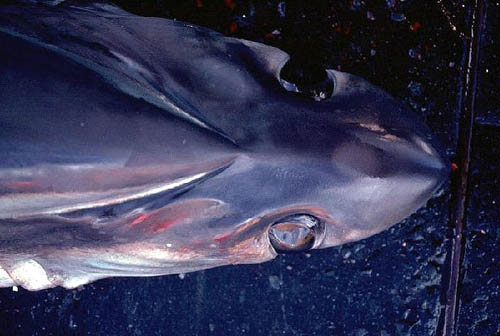
Distinctive Features
Named for an enormous upward looking eye set high in its head, the bigeye thresher is also characterized by an enormous long upper caudal lobe. The upper lobe of the caudal fin can reach lengths of 50% of the total length. This shark also has an indented forehead, a curved broad-tipped pectoral fin, and the free-rear tip of the first dorsal fin is located over or just ahead of the origin of the pelvic fins.
The common thresher shark (Alopias vulpinus) is similar in appearance to the bigeye thresher, however it can be distinguished by its moderately sized eyes which are directed laterally as well as the lack of grooves along the top of its head. Also, the thresher shark has white coloration extending from its abdomen to above the pectoral fins.
As with other Lamniforme sharks, the bigeye thresher possesses an elevated body temperature in relation to its external environment due to a special blood circulatory system, referred to as rete mirabile, which enables it to live in cold environments.
Coloration
The bigeye thresher exhibits counter shading with the dorsal surface having a purplish gray to brownish gray color with metallic hues, while its ventral side is a solid, pale, cream color.
Dentition
The upper jaw of the bigeye thresher consists of between 19-24 teeth while the lower jaw usually has between 20-24 teeth. The teeth, which are similar in the upper jaw and lower jaws, have slender, slightly curved cusps with smooth edges.
 Bigeye thresher denticles: A. Lateral view of small dermal denticle, B. Apical view of same, C. Lateral view of a pair of large dermal denticles. Image courtesy Fishes of the Western North Atlantic
Bigeye thresher denticles: A. Lateral view of small dermal denticle, B. Apical view of same, C. Lateral view of a pair of large dermal denticles. Image courtesy Fishes of the Western North Atlantic Bigeye thresher denticles: A. Lateral view of small dermal denticle, B. Apical view of same, C. Lateral view of a pair of large dermal denticles. Image courtesy Fishes of the Western North Atlantic
Bigeye thresher denticles: A. Lateral view of small dermal denticle, B. Apical view of same, C. Lateral view of a pair of large dermal denticles. Image courtesy Fishes of the Western North Atlantic
Denticles
Bigeye threshers have large and small dermal denticles, with the smaller denticles interspersed among the larger ones. The smaller denticles, which make up the greater percentage, are very widely spaced, shaped like a lance head (tapering to a point at the apex) and are spinous rather than scale-like.
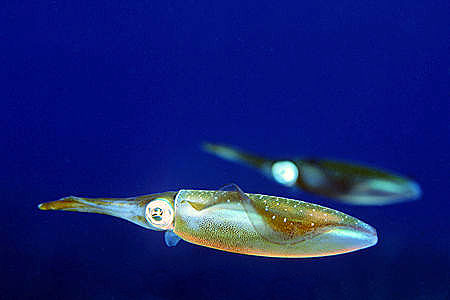
Size, Age, and Growth
The average adult length of the bigeye thresher is between 11-13 feet (335-400 cm) with a maximum reported size of 16 feet (488 cm). The average adult bigeye thresher weight is around 350 pounds (160 kg), with a maximum recorded weight of 759.8 pounds (363.8 kg). The estimated average life span of a male bigeye thresher is 19 years while the female average life span is 20 years. Males mature at a length of approximately 8.86-9.45 feet (270-288 cm) and at an age of around 9-10 years. Females mature at a length of about 10.9-11.7 feet (332-356 cm) and at an age of 12-14 years.
Food Habits
The bigeye thresher generally feeds on benthic and pelagic fish such as tuna, lancetfishes, hake, and herring as well as young billfish. They also feed on squid and various crustaceans. The long caudal fin is used to stun prey prior to its capture.
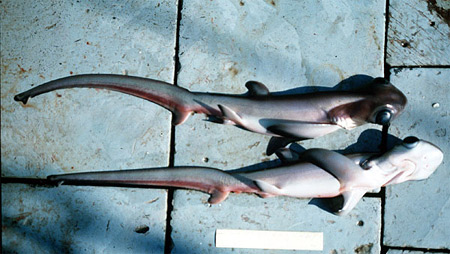
Reproduction
There appears to be no defined breeding season since pregnant females have been caught with embryos at various developmental stages year round. The bigeye thresher is an ovoviviparous species. The eggs develop within the uterus and rather than a placental connection with the mother, the embryos are nourished by yolk stored in the yolk sacs and ovulated eggs (ovoophagy). The mother will give birth to 2-4 young per litter with each pup measuring from 4.27-4.59 ft (130-140 cm) in total length.
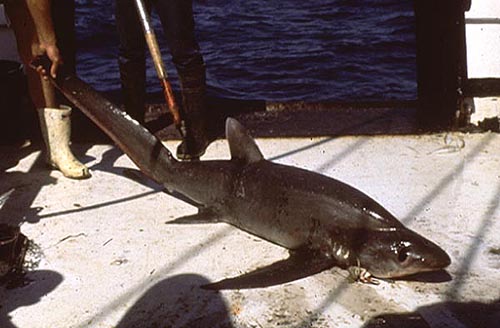
Predators
Larger fish and marine mammals are potential predators of bigeye thresher sharks.
Taxonomy
After the bigeye thresher was originally described, it was referred to by many names including Alopias profundus Nakmura 1935, and Alopecias superciliousus Lowe 1841. The currently valid scientific name for this shark is Alopias superciliosus (Lowe, 1841). The genus name, “Alopias” is from the Greek “alopex” meaning fox. The species name, “superciliosus” is derived from the Latin words “super”, meaning over and above, and “ciliosus”, meaning eyebrow.
Prepared by: Chris Jensen
